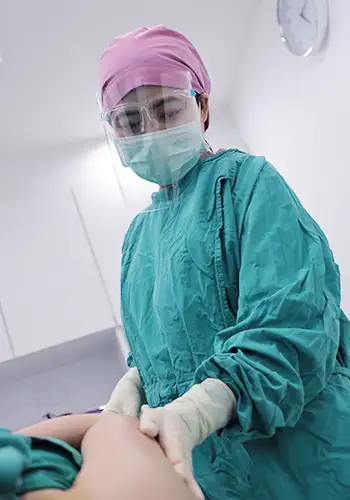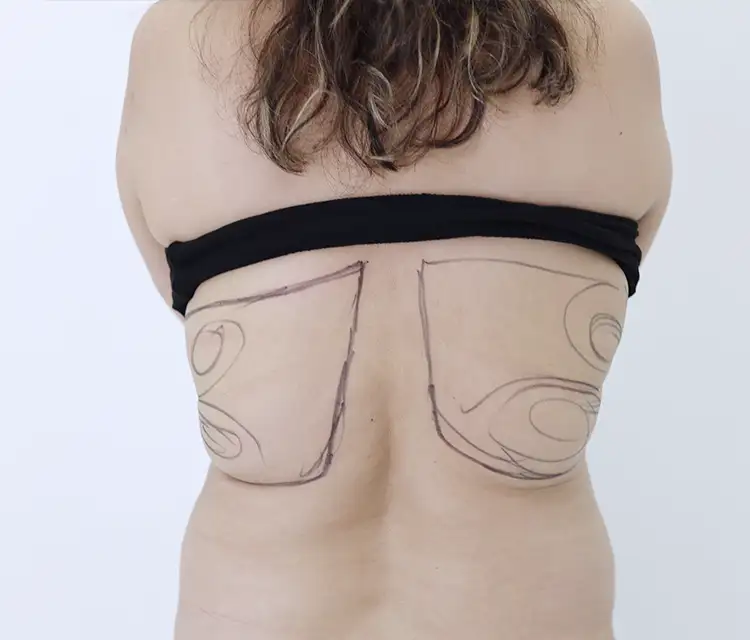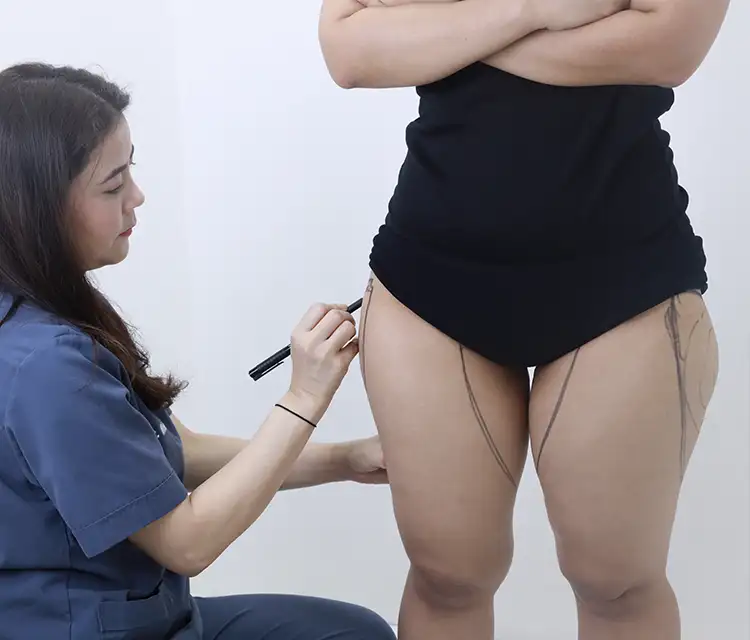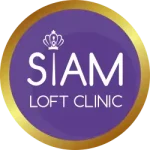Liposuction Review




7 Considerations Before Deciding on Fat Removal
Dr. Nueng would like to offer some insights into the realm of liposuction, gleaned from numerous patient consultations. Many individuals mistakenly believe that liposuction is only applicable to the abdominal region.
In fact, you can suck the whole body, whether it's the upper arms, thighs, abdomen, back wings, calves, you can suck it all. Because the issue of cellulite and excess fat is not mutually exclusive to anyone. From the experience of a doctor who has done at least 50,000 cases, if we eat it, we cannot burn it all off. Let me tell you that even though some people are small, they can still have cellulite. Even more fat, no need to talk about it.
Doctors prefer to refer to the results of liposuction as "contouring" rather than weight loss. In their opinion, liposuction and weight loss are two separate matters.
Some people believe that liposuction can contribute significantly to weight loss, allowing for substantial reductions in body weight. However, in reality, liposuction is merely one option for "body contouring," where excess fat is removed from various areas such as the thighs and arms to tighten and reduce the size of organs, resulting in a better-defined and sleeker physique. This can enhance clothing fit and appearance. While liposuction may contribute to some weight loss, it is not a drastic reduction like losing 10 kilograms. Doctors recommend combining liposuction with dietary control, as it makes it easier to reduce accumulated fat. The outcome depends on the discipline and physical condition of each individual.
Many people fear liposuction because they perceive it as a form of surgery. However, it's important to note that liposuction technology has evolved continuously, and safety has significantly improved. The risks associated with liposuction have greatly decreased, depending on the patient's behavior before and after the procedure, following the doctor's recommendations diligently. Nowadays, liposuction is much less daunting than it used to be, and selecting a reputable beauty service and equipment is another factor that helps reduce these risks. Additionally, consulting with a specialized physician and gathering additional information before undergoing liposuction is advisable.
There are various liposuction machines available today, and the one chosen by the doctor is called Vaser Smooth 2.2. It's the latest technology that excels in fat suctioning. Besides efficiently removing fat, it also prevents the skin from becoming wavy after the procedure, unlike conventional machines. It doesn't damage blood vessels and nerves, causes minimal bruising and swelling, and offers quick recovery. In some cases, patients can return to normal activities shortly after the procedure. (Results may vary for each individual).
- Refrain from smoking at least 2 weeks before and after the surgery to reduce the risk of infection and prolonged swelling (for major surgeries, smoking should be avoided for 1 month after the procedure).
- Avoid aspirin, ibuprofen, or other medications that affect blood clotting, such as anticoagulants and cough medicines containing these ingredients, at least 2 weeks before surgery to minimize bruising from postoperative blood pooling. If necessary, use acetaminophen for pain relief only.
- Avoid herbal supplements and foods containing vitamins A and E for at least 7 days as they may cause difficulty in blood clotting, posing a risk during surgery. Examples include seasoning powder, garlic, onions, soybeans, evening primrose oil, chlorophyll, weight loss pills, antidepressants, almonds, apples, berries, cucumbers, ginger, and tomatoes.
- Inform about any drug allergies, dietary supplements you are taking, and any underlying medical conditions.
- Abstain from food and water for 6 hours before surgery, and it is advisable to take a shower to clean your body and hair.
- Wear comfortable clothes. Shirts with buttons in the front or zippered fronts are recommended for convenience when changing after liposuction.
- Underwear should be disposable. Tops should be sleeveless.
Administering general anesthesia is not necessary for liposuction, as it can be performed under local anesthesia alone. During the procedure, patients can communicate with the surgeon without any sensation in the treated area. Therefore, there is no need to worry about patients who are allergic to anesthesia gas.
The steps involved in liposuction are relatively straightforward, but doctors pay attention to every detail to achieve the desired results for patients and ensure maximum safety. So, what are the specific steps involved?
- The assessment step is considered the first and foremost in the process because the doctor personally speaks with the patient in every case. They inquire about details and self-care practices prior to receiving treatment, assessing whether they have been followed and how. If there are any risks, the doctor will not proceed abruptly because patient safety is paramount. During this initial assessment, the doctor marks the areas to be treated and outlines the specific details of the liposuction procedure.
- Before undergoing liposuction, the doctor instructs the patient to take "before" photos in every case. This is done to closely observe any changes that may occur.
- Prepare for the procedure by having a medical assistant conduct preliminary medication allergy tests and inquire about any recurring illnesses or repeated medication usage before the surgery. Additionally, the area where the liposuction will be performed is cleaned.
- The surgeon will make an incision, which for liposuction is a small incision typically around 0.3 mm, in order to insert the anesthesia delivery device.
- The saline solution mixed with anesthesia is then infused into the area through the device inserted into the small incision, ensuring the patient's comfort during the liposuction process.
- Proceeding to the fat dissolution step with Vaser Smooth 2.2, which breaks down large fat deposits into small emulsified fat, then suctions it out through tubing via the device into the fat collection canister. The amount of fat extracted varies from person to person, depending on individual fat volume. Dr. Nueng ensures thorough fat removal, maximizing the capacity of the procedure.
- After the fat suction process, does the doctor close the incisions or not? It depends on the physician's discretion, but typically, they do not close them. This is because leaving them open allows any remaining saline solution or waste to drain out, facilitating faster healing, reduced swelling, and quicker recovery.
- Caregivers after liposuction will provide information about the initial symptoms that may be encountered, wound care procedures, and post-operative care instructions.
- Clean the wound once a day following your doctor's instructions.
- Use a waterproof plaster to cover the wound before taking a shower each time.
- Do not expose the wound to sunlight as it may cause the wound to darken.
- Wear tight-fitting compression pants continuously for 24 hours in the first 3 days, and thereafter wear them for just 12 hours a day for a period of 3 months to promote blood circulation.
- Wear compression pants consistently for those who have undergone fat suction, to help tighten the skin more quickly.
- If there is an inner wound in the leg area, try to avoid the wound from coming into contact with urine to prevent infection.
- Avoid strenuous activities to prevent wound reopening and reduce muscle inflammation for approximately 3 weeks. After that, gradually increase exercise intensity.
- Avoid consuming salty foods, alcohol, and pickled items to prevent delayed wound healing.
- If there are any abnormal symptoms, promptly consult the patient's physician and strictly follow the doctor's advice and clinic instructions.
Liposuction Review
The collection of reviews for liposuction in each area is all the work of one doctor who performs liposuction.

FACE, WATTLE Review
Liposuction facial reviews can be performed in areas such as the upper and lower cheeks, chin, wattle, and neck. This is particularly beneficial for selfie enthusiasts, as it helps contour and tighten the cheeks, jawline, and face, boosting confidence during selfie sessions.

Upper Arm Review
Liposuction arm reviews can be conducted on the front and side areas of the upper arm, where there is usually excess fat. This procedure helps slim down and contour the arms, addressing concerns such as sagging and unwanted flabbiness.

Belly, Abdomen, Lumbar Review
Review of abdominal liposuction - This procedure can target both the upper and lower abdomen as well as the love handles on the back. Liposuction in these areas can result in a flatter abdomen, an enhanced waist-to-hip ratio, and a sculpted back, depending on the specific areas targeted.

BACK,BRA BULGE Review
Review of liposuction of the back and bra line (under the bra) - This procedure helps enhance confidence when wearing bikinis or fitted shirts, making the body appear slimmer and more proportionate. It also provides a clearer, more defined silhouette, especially visible in photographs.

hips,Legs Review
Review of Inner Thigh Liposuction: This area, from the hips, below the buttocks, to the inner thighs, is where most people commonly struggle. Taking care of this area can significantly slim down your legs, to the point where you might need to change your pant size.

CALVES Review
The thigh area - Many people may think that liposuction is not possible in this area. However, if there is a significant amount of fat, minimal muscle mass, and the tissue feels soft when squeezed, liposuction can be performed. Additionally, liposuction can be combined with injections to further enhance slimming.
